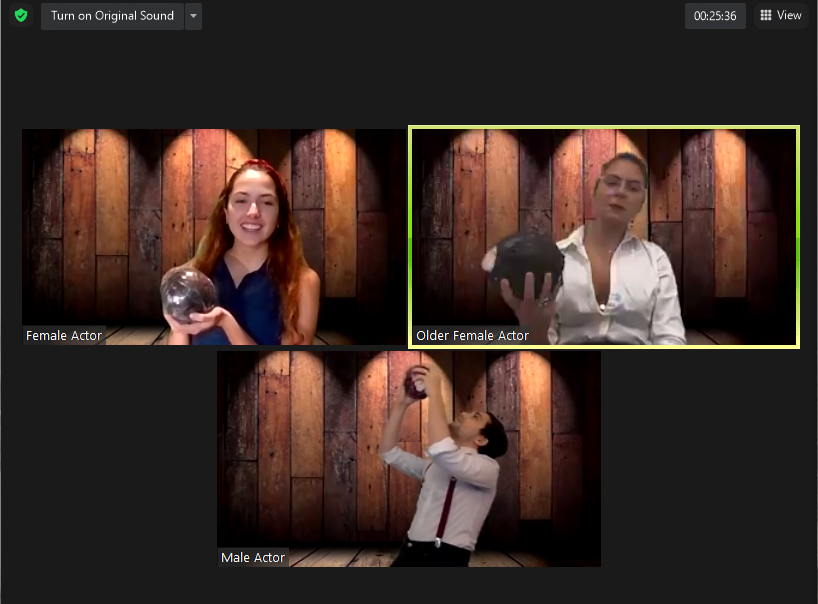Theatre at McGill looks a little different this year. Rather than traditional live productions, which are no longer possible due to public health restrictions, Players’ Theatre went virtual. This is a Play and Life is a Dream were presented through Zoom, running from Oct. 29-31. The McGill Tribune attended each show to find out how Players’ programming has adapted to the challenges of the pandemic.
This is a Play
Noma Mirny
Written by Canadian playwright Daniel MacIvor and directed by Thia McDowell, U3 Arts, the self-referential dramedy This Is A Play examines the lives of three flat characters: Female Actor (Maya Charky, U1 Science), Male Actor (Cédrick Mulcair, Law ‘19), and Older Female Actor (Caroline Lauf, U2 Arts), as they wander around their undisclosed plotless storyline, thinking aloud as actors inside another play.
Starting in a Zoom room, the audience was greeted with doltish Male Actor in suspenders, sardonic Older Female Actor sipping on wine, and ditsy Female Actor flouncing in a blue dress. Throughout the play, the self-aware Actors speak their introspective thoughts on the play, crew, and their relationships to one another. In one moment, the Male Actor starts to grotesquely feign tears about his brother as part of a scene. Male Actor then slyly reveals to the audience how he’s producing such tears: He’s thinking about a cat named Mr. Whiskers.
McDowell’s adaptation of the play to Zoom was excellent and allowed the characters to equally attend to and interact with their virtual context—the Older Female Actor pulls out an off-screen bottle of wine; the Composer (Jordan Prentice, U2 Law) stands up to reveal he is wearing boxers below his suit-jacket. Through a series of clever hints, McDowell suggests that a production is nothing but a farce and that behind every cohesive play is a group of confused, uncoordinated, exhausted people.
In this sharp one-act, McDowell shrewdly reveals that the complex people behind the costumes are as much a part of the production as their scripts, and sometimes even more than the characters themselves.
Life is a Dream
Erika MacKenzie
Director Emma Victoria, U3, adapted Golden Age Spanish Play Life is a Dream by Pedro Calderón de la Barca into a radio play. The story follows Prince Segismundo (Cessy Weber, M.A. Political Science), who has been imprisoned in a tower by his mother, Queen Basillo (Prarthna Isha Mahtani, B.A. ‘19), due to her fear of a prophecy that her son will bring destruction to the kingdom. Segismundo is briefly released, but the prince then embarks on a violent rampage and destroys his land, thus fulfilling the prophecy.
The play explores the themes of fate and free will, reality and delusion, as well as respect and exploitation of the earth. Players’ revamped the centuries-old play to reflect the current environmental crisis: At the end of the play, Segusmundo is forced to confront the fact that he has caused great harm to the earth and the animals, and he must restore the broken relationships between the land and his people.
One of the challenges actors face in a radio play is expressing their character’s emotions in the absence of body language and physical acting. Without the use of video, the actors in Life is a Dream did an excellent job of varying the energy, intonation, and volume of their voices to showcase their character’s state of mind. However, it was occasionally difficult to distinguish who was speaking due to the lack of visual or auditory cues to differentiate the characters.
Sound effects and visual imagery were intermittently used to transition between scenes in the radio play. The brief visuals provided the audience with a clear setting for the action while the sound effects added to the intensity of the scenes. In one scene, Segusmundo storms the kingdom, with sounds of explosions emulating environmental destruction.
Victoria did an excellent job adapting to the circumstances and creating an engaging radio play. Life is a Dream evoked the dissociative feeling of being in a dream and being unable to distinguish reality from illusions—a feeling that continues to be extremely relevant today.








